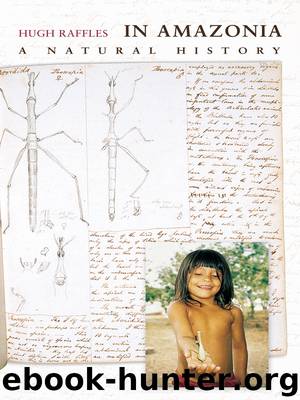In Amazonia by Raffles Hugh

Author:Raffles, Hugh
Language: eng
Format: epub
Publisher: Princeton University Press
Published: 2014-10-15T16:00:00+00:00
IMAGINE THAT YOU ARE WALKING THROUGH A FOREST
Imagine that you are walking through a forest of interarticulated branches. Some are covered with ice or snow, and the sun melts their touching tips to reveal space between. Some are so thickly brambled they seem solid; others are oddly angular in nature, like esplanaded trees.
Some of the trees are wild, some have been cultivated. Some are old and gnarled, and some are tiny shoots; some of the old ones are nearly dead, others show green leaves….
Your job is to describe this forest. You may write a basic manual of forestry, or paint a landscape, compose an opera, or improve the maps used throughout. What will your product look like? Who will use it?
—Geoffrey Bowker and Susan Leigh Star43
By July, the mahogany fruits are falling in Fazendinha. Large, pendulous, pear-shaped, and woody, they burst open like stars and the long, elegant seeds break free and spin, scattering downwind, burying themselves in the forest floor.
Monday to Saturday at this time of year, Paul and his field crew—Luiz, Jaime, Ana, Paulo, Gato, and Mandioca—leave camp early, when the wet of the morning still makes you shiver, and drive the pickup out to one of the talhões. Paul has allocated tasks the night before in conversation with Luiz or Jaime, and all is subdued and businesslike.
After three years of concentrated activity, this is going to be a short field season for Paul. A fourth year’s data is something of a coup, providing an exceptional longitudinal depth to what is already, with over 600 subject trees, the largest study of neotropical mahogany in progress. Armed with maps that locate each tree in the talhão, the crew sets about recording growth increments, fruit and seed production, mortality, and phenological behavior (the timing of leaf-flush and reproductive activity). Although this is the central piece of the Project, there are numerous supplementary studies in place, some of which involve researchers with other specializations: comparative treatment plots manipulating light, moisture, and nutrients to simulate specific types of disturbance; ongoing measures of climate and water table; regular monitoring of the effects of pests and vines; and detailed investigation of both pollination mechanisms and population genetics.
Not only year on year, but day by day and hour by hour, this field recording of growth and reproduction is profoundly repetitive work. Efforts are concentrated in talhões 1–6, with the most comprehensive data collected in 2, 3, and 4. All live mahogany trees in these 1,100 hectares have been mapped using a compass, clinometer, distance tape, and machete. All stumps and dead stems also—standing and fallen—and all the streams too. Imagine the labor involved.
Unsurprisingly, the map is the foundational technology of the Project, an artifact that bears a double burden of visibility, structuring the meaning of this forest both here, as we trudge along these many miles of trails, and there, as Paul hawks the FMP around offices and seminar rooms, searching now for backers and buyers. Without the map, this forest could neither leave Pará
Download
This site does not store any files on its server. We only index and link to content provided by other sites. Please contact the content providers to delete copyright contents if any and email us, we'll remove relevant links or contents immediately.
Man-made Catastrophes and Risk Information Concealment by Dmitry Chernov & Didier Sornette(4818)
The Revenge of Geography: What the Map Tells Us About Coming Conflicts and the Battle Against Fate by Kaplan Robert D(3629)
Zero Waste Home by Bea Johnson(3333)
COSMOS by Carl Sagan(2990)
In a Sunburned Country by Bill Bryson(2987)
Good by S. Walden(2953)
The Fate of Rome: Climate, Disease, and the End of an Empire (The Princeton History of the Ancient World) by Kyle Harper(2471)
Camino Island by John Grisham(2426)
A Wilder Time by William E. Glassley(2393)
Organic Mushroom Farming and Mycoremediation by Tradd Cotter(2330)
Human Dynamics Research in Smart and Connected Communities by Shih-Lung Shaw & Daniel Sui(2206)
The Ogre by Doug Scott(2152)
Energy Myths and Realities by Vaclav Smil(2092)
The Traveler's Gift by Andy Andrews(2044)
Inside the Middle East by Avi Melamed(1968)
Birds of New Guinea by Pratt Thane K.; Beehler Bruce M.; Anderton John C(1935)
Ultimate Navigation Manual by Lyle Brotherton(1794)
A History of Warfare by John Keegan(1751)
And the Band Played On by Randy Shilts(1659)
